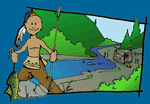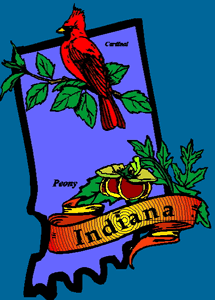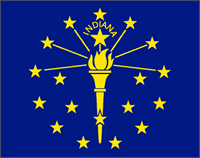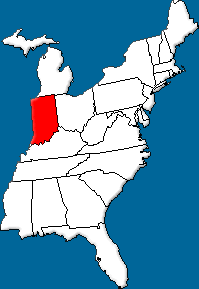 History:
The first European explorer to come to Indiana was Robert Cavalier, Sieur de la Salle. He entered the region in 1679 from the Canadian French colonies, seeking a water route to the Pacific Ocean.
In the years after La Salle's exploration, French fur traders came inland from the Great Lakes to trade with Native Americans and built posts near present day Fort Wayne and Lafayette. In 1731 they established the first permanent settlement in Indiana - Vincennes.
The British were also interested in the fur trade and were in competition with the French. The French were well accepted by the Indians because they treated them as equals. However, the British began offering higher prices for furs and soon won over the Native Americans. This competition was largely responsible for a series of wars between the French and British in North America. In 1763, the Treaty of Paris ended the French and Indian Wars and Indiana fell under control of the British.
During the Revolutionary War (1774-1783) British troops occupied the Indiana region and took control of Vincennes. The city was eventually reclaimed by Virginia troops in 1778. With this victory, America gained control of the Northwest. In 1787 Indiana became part of the Northwest Territory.
Early settlers in Indiana were plagued by frequent Indian attacks. Native Americans resented the presence of the settlements. The Miami tribe, led by Chief Little Turtle, was responsible for burning homes and killing many settlers. In 1794, the Miami and other tribes were defeated in the Battle of Fallen Timbers, near present day Toledo.
Congress officially created Indiana Territory in 1800. This area included the states of Indiana, Illinois, and parts of Michigan and Minnesota. The capital of Indiana was established at Vincennes and William Henry Harrison became governor of the territory.
Harrison purchased 2.9 million acres of Indian lands for the federal government in 1809. This angered the Shawnee chief Tecumseh who soon obtained ammunition from the British and prepared for war. Tecumseh was defeated by Harrison at the Battle of Tippecanoe, near present day Lafayette, in 1811.
During the War of 1812 (1812-1815), the British and the Indians combined forces against the Americans but they were defeated by Harrison at the Battle of the Thames, at Moraviantown, Ontario. Chief Tecumseh was killed in this battle. Soon Indian attacks stopped and British influence in the territory came to an end. Corydon became the new capital of Indiana Territory in 1813.
In 1816, Indiana entered the Union as the 19th state. It soon became the site for several experimental communities. In 1825, Scottish social reformer Robert Owen founded New Harmony (in the lower Wabash River Valley). He hoped to create a new social system and plan for community living. The community included many scholars, teachers, and scientists. Ultimately, the project failed because of lack of cooperation among its participants, but many progressive ideas, especially in education, were developed there.
Indiana's transportation system grew and prospered during the mid-19th century. The Wabash and Erie Canal, connecting Indiana with Lake Erie, opened in the 1840s. The canal gave the state access to trade with the East. That same year, the state's first railroad line, connecting Indianapolis with Madison, was completed. Soon Indiana's cities began to experience tremendous growth. Improved transportation also enabled the state's farmers to find new markets for their crops.
Indiana supported Abraham Lincoln in the election of 1860 and, despite some proslavery sentiment, remained committed to the Union cause. Indiana saw little military action during the Civil War. The only known conflict on Indiana soil occurred in 1863 when Confederate General John Hunt Morgan led a raid at Corydon.
Industry, which had grown rapidly as a result of the needs of the Civil War, continued to prosper as new factories sprang up in the later half of the 19th century. |









